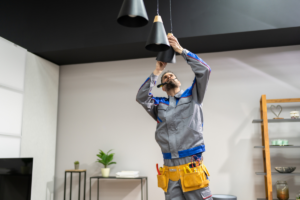
Are you tired of high energy bills and looking for ways to make your home more efficient? You’re not alone. Many homeowners are discovering the benefits of energy-efficient home improvements, not just for the environment but for their wallets too. In this post, we’ll guide you through the top seven energy-efficient upgrades that can transform your home into a money-saving powerhouse.
From simple changes like switching to LED lighting to more significant investments like installing solar panels, each improvement is designed to reduce your energy consumption and lower your monthly bills. We’ve researched and compiled the best options, so you don’t have to.
Get ready to embark on a journey toward a more sustainable and cost-effective home. With our expert advice, you’ll learn how to make smart choices that benefit both your budget and the planet. Let’s dive into these energy-saving solutions and start making a difference today.
Energy-Efficient Home Improvements hacks
As energy costs continue to rise and environmental concerns become more pressing, making energy-efficient home improvements is a smart move. Not only can these upgrades reduce your carbon footprint, but they can also lead to significant savings on your utility bills. In this blog post, we’ll explore the top 7 energy-efficient home improvements that can help you save money and create a more sustainable living environment.
-
Replace Ceiling Fans
Replacing your old ceiling fans with energy-efficient models is a simple yet effective home improvement that can have a big impact. Energy-efficient ceiling fans use advanced motor technology to reduce energy consumption while providing the same or better airflow as traditional fans. Look for fans with the ENERGY STAR® label, which are certified to be at least 60% more efficient than conventional models.
Ceiling fans help circulate air in your home, making it feel cooler in the summer and warmer in the winter. By using your ceiling fans in conjunction with your heating and cooling systems, you can reduce the need for these systems to run constantly, thereby saving energy and lowering your utility bills.

-
Insulate Attic
Attic insulation is one of the most effective energy-efficient home improvements you can make. Proper insulation helps maintain a consistent temperature in your home by preventing heat from escaping in the winter and keeping it out in the summer. This reduces the workload on your HVAC system, leading to lower energy consumption and cost savings.
There are various insulation materials available, including fiberglass, cellulose, and spray foam. Each has its advantages, so it’s important to choose the one that best suits your home’s needs. Proper installation is crucial to ensure maximum efficiency, so consider hiring a professional to get the job done right.
-
Install a Smart Programmable Thermostat
A smart programmable thermostat is a game-changer when it comes to energy-efficient home improvements. These devices allow you to control your home’s temperature remotely and set schedules to ensure your HVAC system operates only when needed. By optimizing your heating and cooling schedules, you can significantly reduce energy waste and lower your utility bills.
Smart thermostats learn your preferences over time and can make automatic adjustments to keep your home comfortable while minimizing energy use. Many models also provide energy usage reports, helping you identify patterns and areas for further improvement. Installing a smart programmable thermostat is a relatively easy upgrade that offers substantial long-term benefits.
-
Switch Out Lightbulbs
Switching out your old incandescent lightbulbs for energy-efficient alternatives is one of the simplest and most cost-effective home improvements you can make. LED bulbs use up to 80% less energy than traditional incandescent bulbs and last much longer. This means you’ll save money on both your energy bills and replacement costs.
LED bulbs are available in various color temperatures and brightness levels, making it easy to find the perfect lighting for every room in your home. Additionally, many LEDs are compatible with dimmer switches, allowing you to further reduce energy consumption and create the perfect ambiance.
-
Buy a New Refrigerator
If your refrigerator is more than ten years old, it might be time to consider upgrading to a newer, more energy-efficient model. Modern refrigerators use significantly less energy than older models, thanks to advancements in insulation, compressor technology, and design. Look for refrigerators with the ENERGY STAR® label, which are certified to use at least 15% less energy than the minimum federal standard.
An energy-efficient refrigerator not only reduces your electricity consumption but also helps keep your food fresher for longer, thanks to improved temperature control and humidity management. When shopping for a new refrigerator, consider factors such as size, configuration, and additional features to find the best fit for your needs and budget.
-
Insulate the Water Heater
Insulating your water heater is a simple yet effective energy-efficient home improvement that can lead to significant savings. An insulated water heater reduces heat loss, meaning your water heater doesn’t have to work as hard to maintain the desired temperature. This can result in lower energy consumption and reduced utility bills.
Water heater insulation blankets are affordable and easy to install. They are designed to fit over your existing water heater, providing an extra layer of insulation. Be sure to follow the manufacturer’s instructions and safety guidelines when installing an insulation blanket to ensure proper performance and safety.
-
Bundle Up Water Lines
Bundling up your water lines is another effective way to improve energy efficiency in your home. Insulating hot water pipes helps reduce heat loss, ensuring that hot water reaches your faucets faster and stays hot longer. This means you won’t need to run your water heater as frequently, leading to energy savings and reduced wear and tear on your system.
Pipe insulation is relatively inexpensive and easy to install. Foam pipe insulation sleeves are available in various sizes and can be easily cut to fit your pipes. By insulating your water lines, you can improve your home’s energy efficiency and enjoy the benefits of lower utility bills and increased comfort.
Making these energy-efficient home improvements can lead to significant savings on your utility bills while also reducing your environmental impact. By replacing ceiling fans, insulating your attic, installing a smart programmable thermostat, switching out lightbulbs, buying a new refrigerator, insulating your water heater, and bundling up water lines, you can create a more sustainable and cost-effective home.
Not only do these improvements help you save money, but they also enhance your home’s comfort and value. Energy-efficient home improvements are an investment in your future, offering long-term benefits that go beyond immediate cost savings. By taking these steps, you’re contributing to a greener planet and setting an example for others to follow.
Whether you’re a seasoned DIY enthusiast or just getting started with home improvements, there are plenty of resources available to help you along the way. From online guides and tutorials to professional services, you can find the support you need to make your home more energy-efficient. Remember, every small change adds up, and together, we can make a big difference.
So, what are you waiting for? Start making these energy-efficient home improvements today and enjoy the benefits of a more sustainable and cost-effective home. Your wallet, your home, and the planet will thank you.


